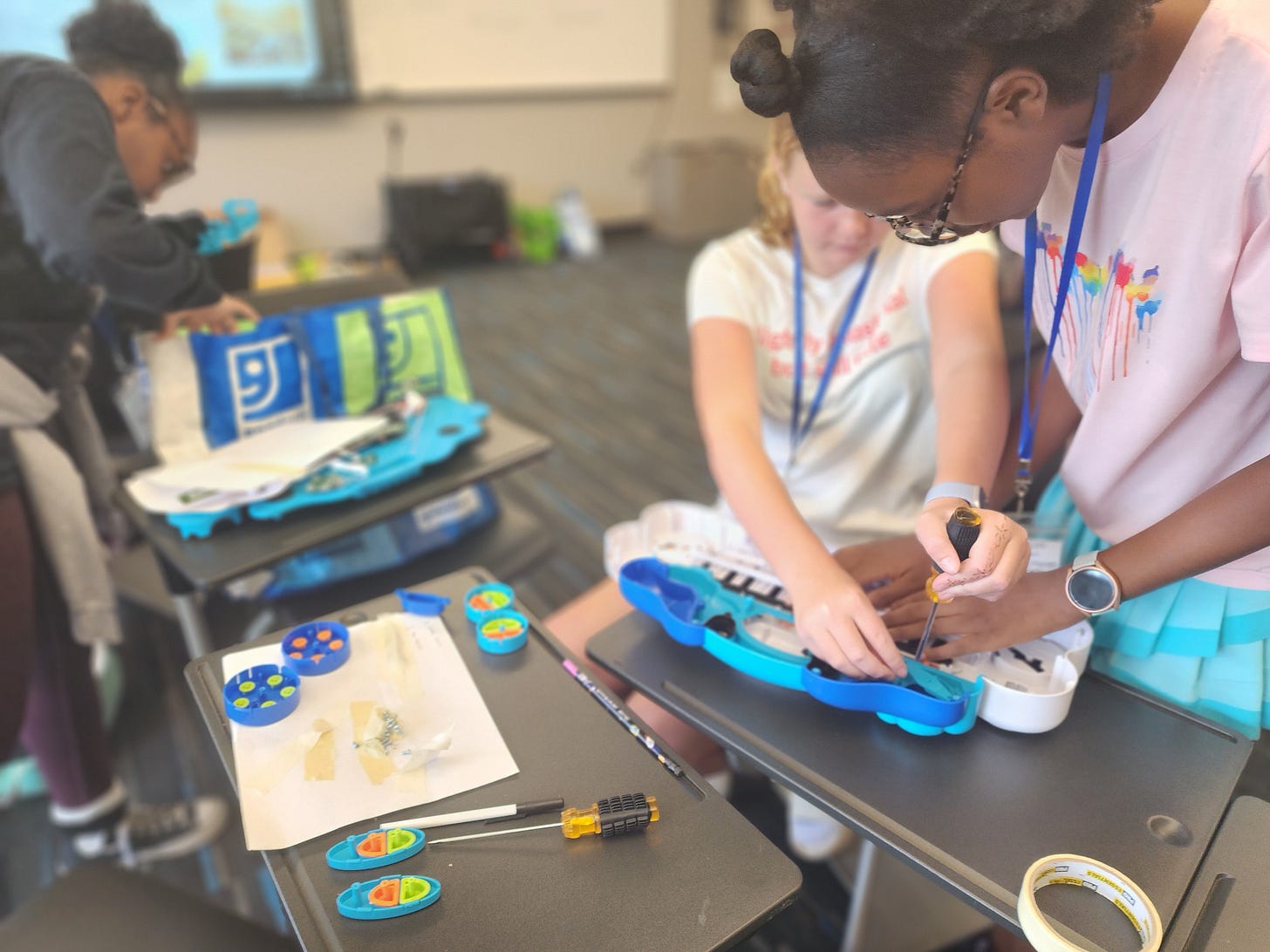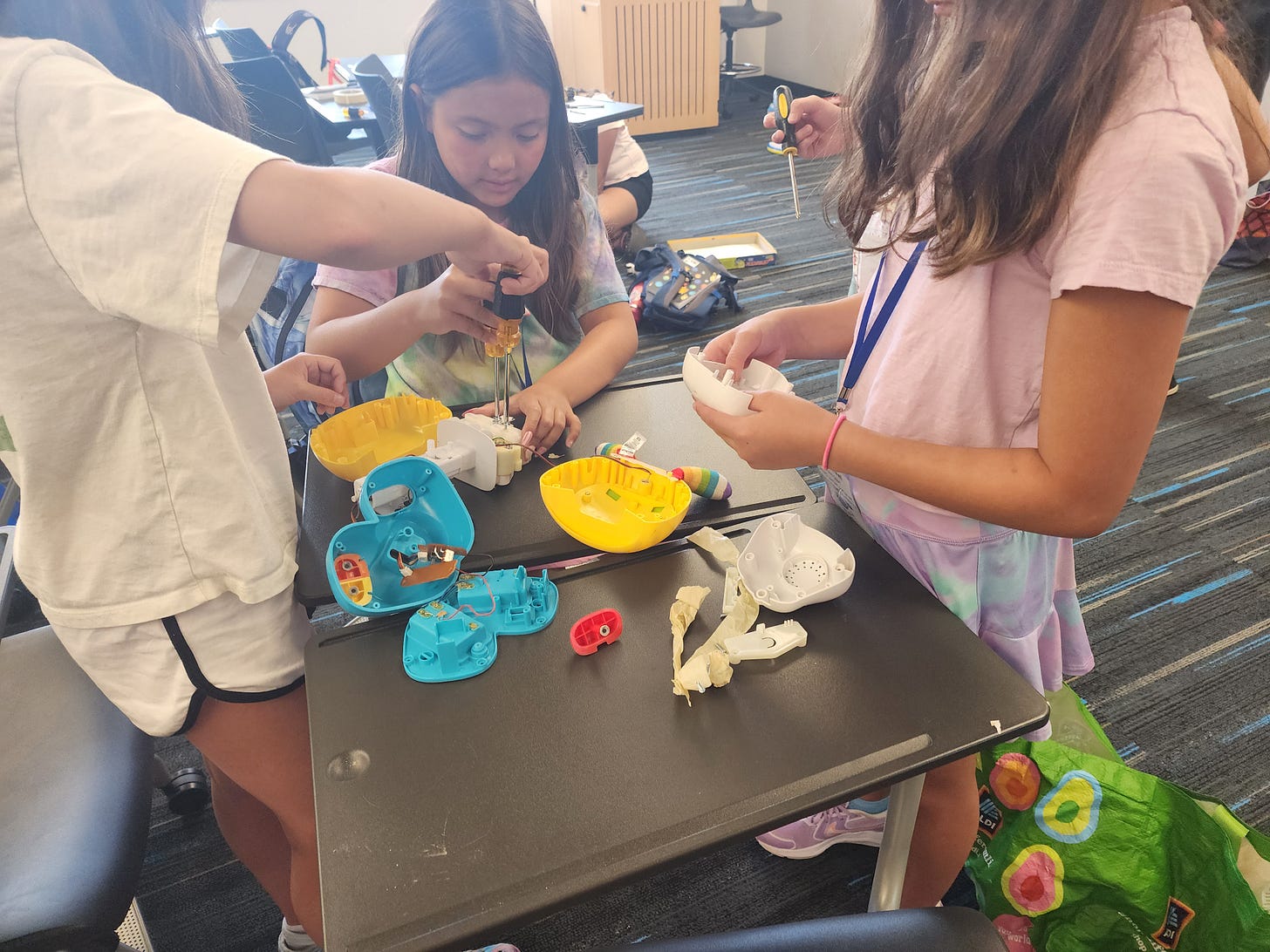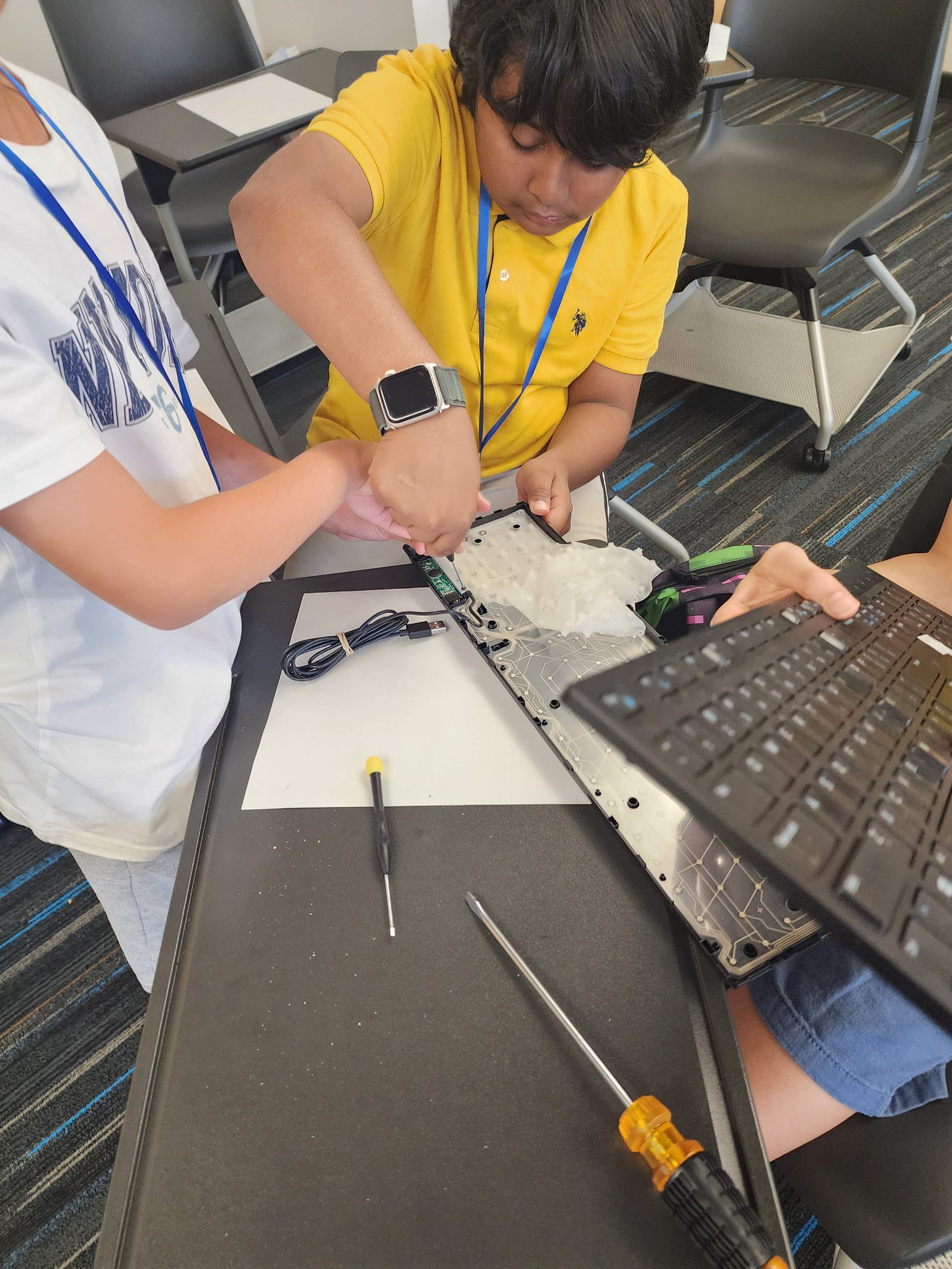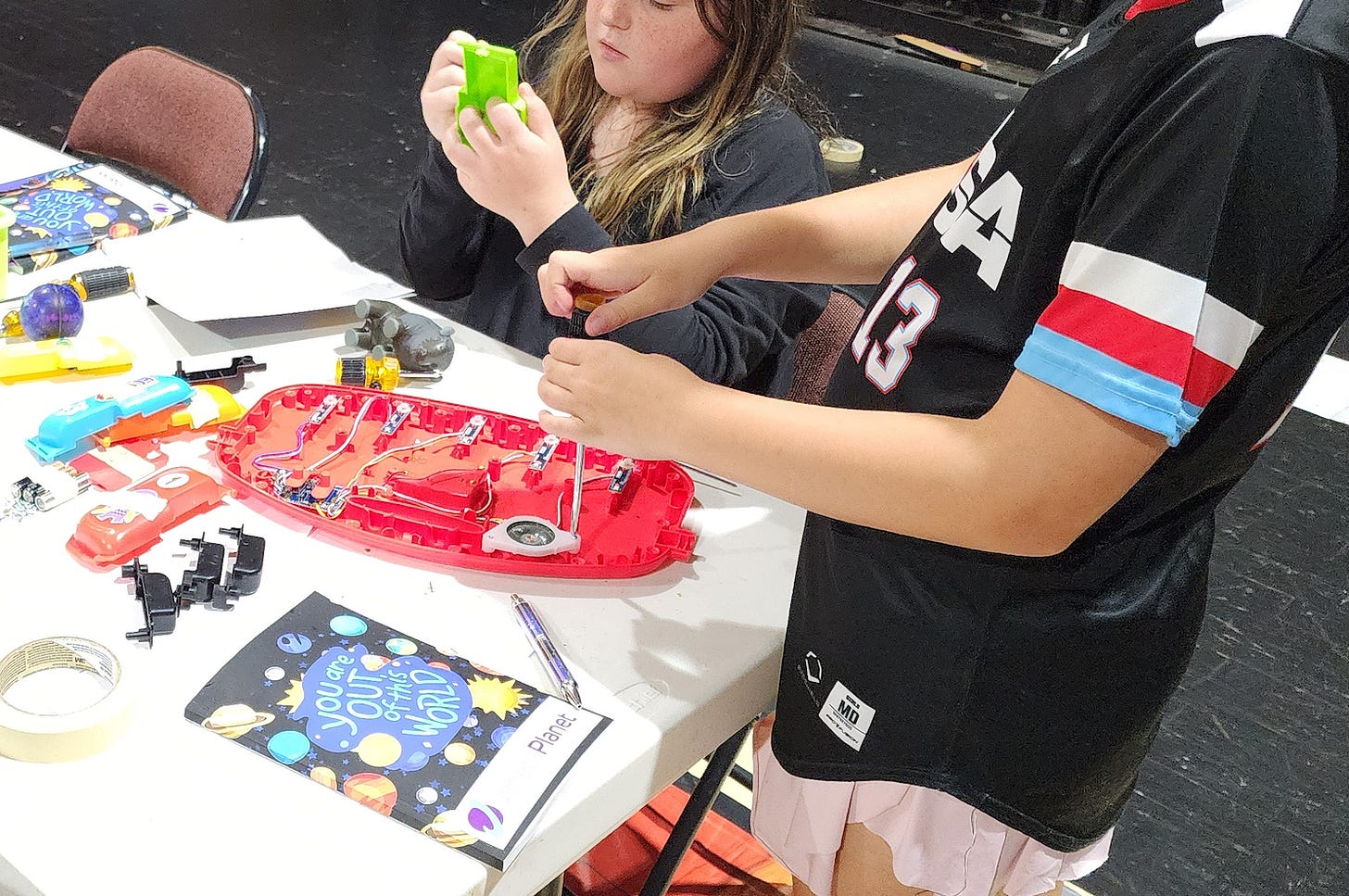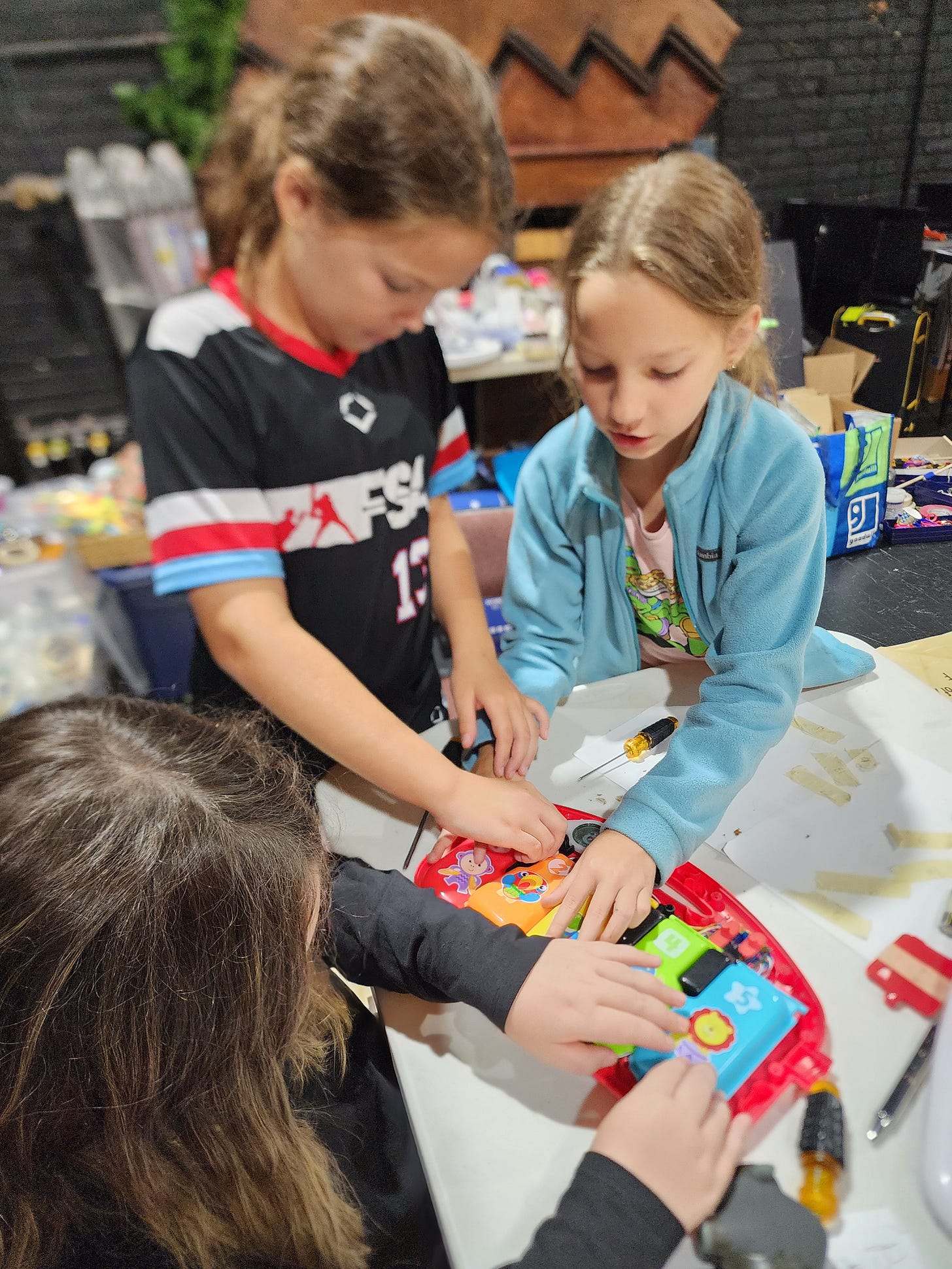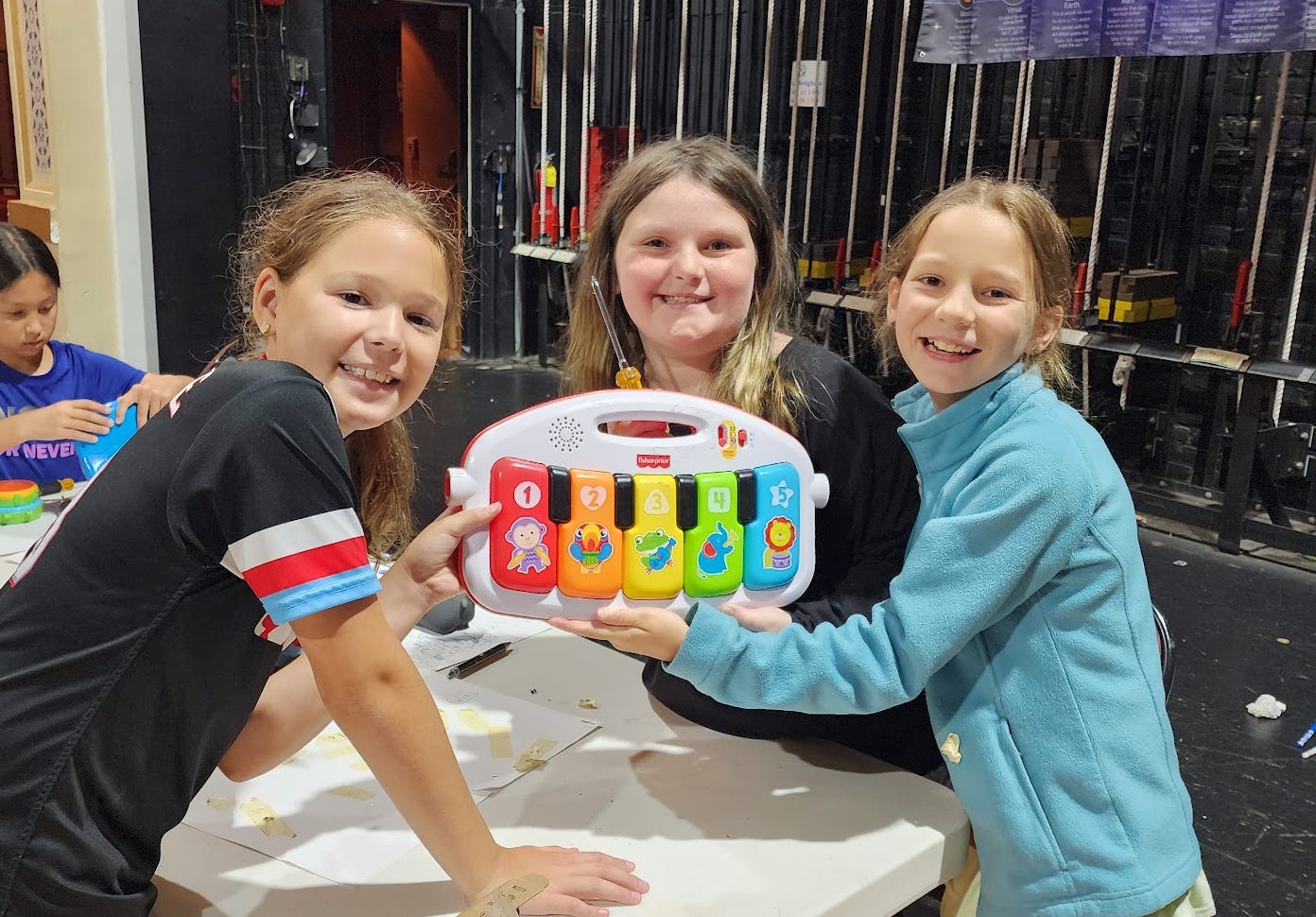What I Did This Summer: Field Notes from The Janet's Planet Astronaut Academy
Screwdrivers + Boundaries + Love + Permission to TRY
This summer, I taught camps across the country. In every city, a pattern emerged…not in the stars but in the small, human moments: a child who couldn’t tear tape; shoelaces left untied; a classroom that went silent when I handed out a Phillips and a flathead screwdriver and said, “Take it apart, figure out how it works, and put it back together.”
My favorite moment? Three girls, ages 9, 10, and 11, deconstructed a toy piano, found a depressed button, fixed it, and reassembled the instrument. We put batteries in and much to my and THEIR SURPRISE!…It played again, and they absolutely lit up with JOY!. The act of entrusting them with tools—and a challenge—was the spark. It wasn’t the piano that changed; it was their sense of themselves.
Boundaries + love + expectation = results! Multiple campers with varying spectrum issues said JPAA was their favorite camp this summer, proving that our “love first, teach second” model works.
Below are field notes, what the research says, and a practical playbook for parents and educators who want to help kids thrive: body, brain, and spirit.
Field Notes (Summer 2025)
Tool literacy is thin. Many kids don’t know the difference between a Phillips (“plus sign”) and a flathead (well…flat), or how to tear packing tape safely and cleanly.
Midline crossing, core strength, and hand strength need love. I observed numerous instances of W-sitting, trouble with bilateral tasks (stabilizing with one hand and manipulating with the other), and difficulty with tasks such as tearing, squeezing, tying, and twisting.
Self-care skills are delayed. A surprising number of nine-year-olds couldn’t tie their own shoes.
Screens crowd out movement and make attention fragile. Not universally, but often enough to matter.
Communication gaps matter. While we ask for information that will help us better serve the camper families don’t always disclose 504/IEP or ASD details. I understand why: privacy, stigma, fear of exclusion, but surprises in a group of 60 can be hard on everyone, including that child.
None of this is a moral failing. It’s a systems issue: less unstructured play, more screens, fewer chances to climb, dig, carry, twist, and try. Additionally, there is the understandable instinct to keep kids “safe” by keeping them away from anything sharp, heavy, or messy.
What the Research Says
Bodies need daily vigorous movement. U.S. guidelines recommend 60 minutes or more of moderate-to-vigorous activity daily for children aged 6–17. Multiple national snapshots suggest only ~20–28% of U.S. youth consistently meet that mark, and the trend hasn’t improved. The practical point: most kids need more chances to move, lift, hang, jump, and climb. CDC+1Gillings School of Public Health
Screens aren’t evil, but dose and context matter. Systematic and longitudinal studies link higher screen time in early childhood with poorer executive function and other developmental risks; effects vary with content and what screen time displaces (sleep, physical play, social interaction). AAP now emphasizes a Family Media Plan over one-size-fits-all limits. Here’s what you can do: curate content, co-view when possible, and protect time for two-handed, whole-body play. munideporte.comJAMA Network+1HealthyChildren.org
Hand strength and practical skills matter. Handgrip is a well-established proxy for overall strength and function; several large-scale analyses have reported declines in youth grip strength over recent decades in multiple countries, consistent with a decrease in daily vigorous movement and manual tasks. Translation: opening jars, tearing tape, twisting screws…ALL of it is “PE for the hands.” e-arm.orgWikipedia
Crossing the midline and engaging in bilateral work help improve attention. Brief, daily, coordinated bilateral activities (e.g., “opposite elbow to knee,” ball skills that cross the body) have been shown to improve attention and concentration in elementary students in controlled studies. Movement snacks aren’t a gimmick; they’re neural nutrition. Wiley Online LibraryPMC
W-sitting: don’t panic, encourage variety: Weak Core and Trunk Muscles:
W-sitting provides a stable base, requiring less core muscle engagement than other sitting positions. This can hinder the development of core strength and stability, which are essential for maintaining proper posture, balance, and overall motor skills. W-sitting places the hips in internal rotation and flexion, potentially leading to tightness in the hip internal rotators and hamstrings. The position can also contribute to muscle imbalances around the hips, which can affect movement patterns and coordination. The practical guidance: it’s fine sometimes; aim for varied positions and plenty of core/hip-strengthening movement, especially if W is the only way a child sits. Children's Hospital Los AngelesPMC
Boundaries are an act of love. Decades of research on parenting styles have shown that authoritative approaches, characterized by warmth and clear, consistent limits, are associated with better academic and behavioral outcomes than either harsh control or PERMISSIVENESS (sorry, parents, you know who you are.) Kids feel safer (and often happier) when the grown-ups are both kind and in charge. PMCPubMed
Self-care milestones are teachable, not automatic. Many children can learn to tie shoes between 6–8, but only if we let them try (and fumble) repeatedly. Daily practice beats waiting for readiness. CDC
A Practical Playbook (Home or Classroom)
1) Two Screwdrivers, One Big Idea (Deconstruct → Improve → Rebuild)
What you do: Offer a Phillips and a flathead; let kids hypothesize what’s inside a (safe) device, disassemble systematically, diagnose, improve/repair, reassemble, and reflect.
Why it works: It’s NGSS-aligned engineering, which involves asking questions, defining problems, testing solutions, and building tool literacy and self-efficacy through “productive struggle.” Next Generation Science Standards+1DocDrop
2) Movement Snacks that Cross the Midline (4–6 minutes)
Try: Cross-crawl marches, figure-8 ball passes around the waist and between legs, opposite-hand toss & catch, lazy-8s on a wall with both hands.
Why: Short, coordinated bilateral bouts improve attention and concentration; they also build the bilateral control needed for writing, tying, and tool use. Wiley Online Library
3) Hand-Strength Builders (No gym required)
Try: Play-doh “pinch-roll-twist,” clothespin art, squeeze-bottle watercolor, crumple-and-smooth paper balls, and a daily “tape test” (stabilize the roll, then tear cleanly on the blade).
Why: Strength + dexterity support everything from scissors to shoelaces. The trend data on grip strength is a nudge to bring back manual play. e-arm.org
4) Shoe-Tying Boot Camp (7 minutes/day for 2 weeks)
Script: “Loop, wrap, pinch, pull, slow is smooth; smooth is fast.” Teach on a knee-high practice board first; then transfer to the shoe. Celebrate near-misses.
Why: Self-care grows confidence and frees cognitive bandwidth for learning. CDC
5) Screens with Intention, Not Guilt
Do: Create a Family Media/Screen Time Plan (include screen-free zones like mealtimes and car rides; protect sleep; co-view high-quality content).
Don’t: Treat all screen use the same. It’s what the screen replaces that often matters. HealthyChildren.org
6) Boundaries that Feel Like Belonging
Try: 3 clear rules, visual schedules, “when/then” language (“When the tool is returned, then you choose the next station”), and consistent follow-through.
Why: Warmth + structure correlates with better outcomes. Kids often report more enjoyment once expectations are clear. PMC
Why I’m Saying This (and Why I’m Hopeful)
I’ve worked with kids for 33 years. The age of innocence has shifted significantly younger; combine that with the social/emotional immaturity of chronological age and unlimited screen time, and…Houston, we have a problem. But it’s a solvable problem. When we entrust kids with real tools, ask them to do hard things, pair that ask with warmth and boundaries, KIDS. WILL. RISE. Those three girls with the piano didn’t just fix an instrument…they REWIRED their belief about what they can do.
If you try any of the activities above, I’d love to hear about your experiences. And if you’re a parent or educator who’s found your own “two-screwdriver” moment, drop it in the comments—let’s build a library of small experiments that return big joy.

